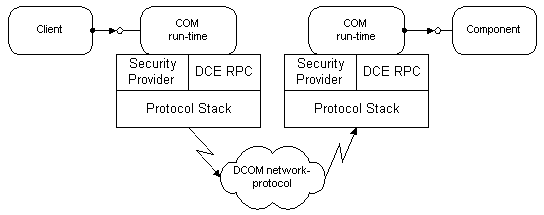





Published on Feb 14, 2025
Microsoft® Distributed COM (DCOM) extends the Component Object Model (COM) to support communication among objects on different computers-on a LAN, a WAN, or even the Internet. With DCOM, your application can be distributed at locations that make the most sense to your customer and to the application.
Because DCOM is a seamless evolution of COM, the world's leading component technology, you can take advantage of your existing investment in COM-based applications, components, tools, and knowledge to move into the world of standards-based distributed computing. As you do so, DCOM handles low-level details of network protocols so you can focus on your real business: providing great solutions to your customers.
DCOM is an extension of the Component Object Model (COM). COM defines how components and their clients interact. This interaction is defined such that the client and the component can connect without the need of any intermediary system component. The client calls methods in the component without any overhead whatsoever.

In today's operating systems, processes are shielded from each other. A client that needs to communicate with a component in another process cannot call the component directly, but has to use some form of interprocess communication provided by the operating system. COM provides this communication in a completely transparent fashion: it intercepts calls from the client and forwards them to the component in another process. Figure 2 illustrates how the COM/DCOM run-time libraries provide the link between client and component.

When client and component reside on different machines, DCOM simply replaces the local interprocess communication with a network protocol. Neither the client nor the component is aware that the wire that connects them has just become a little longer.
Figure 3 shows the overall DCOM architecture: The COM run-time provides object-oriented services to clients and components and uses RPC and the security provider to generate standard network packets that conform to the DCOM wire-protocol standard.

Most distributed applications are not developed from scratch and in a vacuum. Existing hardware infrastructure, existing software, and existing components, as well as existing tools, need to be integrated and leveraged to reduce development and deployment time and cost.
DCOM directly and transparently takes advantage of any existing investment in COM components and tools. A huge market for off-the-shelf components makes it possible to reduce development time by integrating standardized solutions into a custom application. Many developers are familiar with COM and can easily apply their knowledge to DCOM-based distributed applications.
Any component that is developed as part of a distributed application is a candidate for future reuse. Organizing the development process around the component paradigm lets you continuously raise the level of functionality in new applications and reduce time-to-market by building on previous work.
Designing for COM and DCOM assures that your components are useful now and in the future. With DCOM these critical design constraints are fairly easy to work around, because the details of deployment are not specified in the source code. DCOM completely hides the location of a component, whether it is in the same process as the client or on a machine halfway around the world.
In all cases, the way the client connects to a component and calls the component's methods is identical. Not only does DCOM require no changes to the source code, it does not even require that the program be recompiled. A simple reconfiguration changes the way components connect to each other.
DCOM's location independence greatly simplifies the task of distributing application components for optimum overall performance. Suppose, for example, that certain components must be placed on a specific machine or at a specific location.
If the application has numerous small components, you can reduce network loading by deploying them on the same LAN segment, on the same machine, or even in the same process. If the application is composed of a smaller number of large components, network loading is less of a problem, so you can put them on the fastest machines available, wherever those machines are.
| Are you interested in this topic.Then mail to us immediately to get the full report.
email :- contactv2@gmail.com |